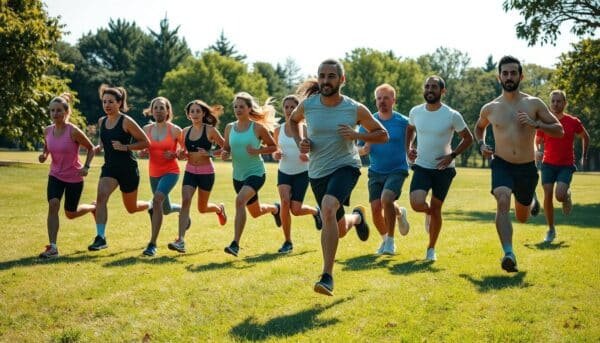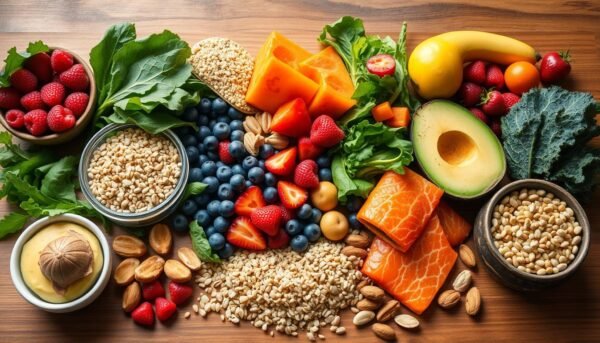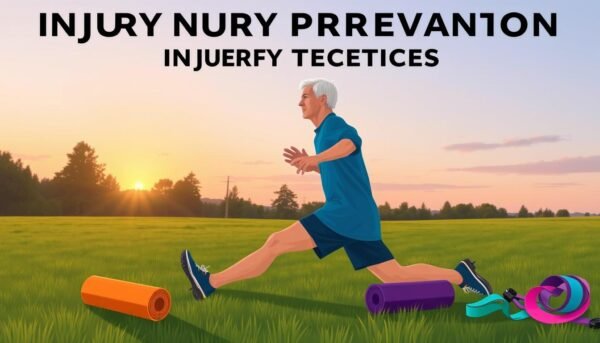As I look at the scale, I feel frustrated. The weight doesn’t come off like it used to. But I won’t give up. I know I can get my health back, even in my 40s.
If you’re struggling to lose weight after 40, you’re not alone. Our bodies change a lot as we age. But running might be the answer to losing weight.
Running is great for losing weight. It burns up to 272 calories in 30 minutes for a 150-lb person. It also improves heart health, boosts mood, and can even make you live longer.
In this article, we’ll look at running workouts for weight loss after 40. We’ll share strategies and techniques for success. Get ready to start your health journey with running.
Understanding Age-Related Changes in Metabolism After 40

As we get older, our bodies change in ways that affect our metabolism and weight. Losing muscle mass, or sarcopenia, is a big part of this. By 40, we might lose 3% to 5% of muscle each decade if we’re not active.
Muscle burns more calories than fat. So, when we lose muscle, our metabolism slows down. Hormonal changes, especially during menopause, make it harder to lose weight.
Impact of Muscle Mass Loss on Weight Management
As we age, losing muscle mass makes it harder to manage our weight. Men usually have a faster metabolism because of more muscle, heavier bones, and less fat. But, as both men and women lose muscle, this advantage fades.
Hormonal Changes and Their Effect on Weight
Hormonal changes, like lower estrogen and testosterone, can lead to weight gain. Hormones and genetics slow down metabolism as we age. Knowing about these changes helps us find ways to manage our weight better.
Metabolic Adaptations in Midlife
In our 40s and beyond, our bodies adapt to changes in muscle and hormones. Doctors say we should exercise for at least 30 minutes, 5 days a week, to boost metabolism. Eating right, staying hydrated, and managing health issues also help fight metabolic slowdown.
Understanding these changes helps us take steps to manage our weight and stay healthy in midlife.
Benefits of Running for Weight Loss After 40

Running can help you manage your weight in midlife. It burns a lot of calories and keeps burning them even after you stop. Plus, it’s easy to do without much gear.
Running does more than help you lose weight. It makes your heart stronger, lifts your mood, and keeps your bones and lungs healthy. It’s great for your overall health, no matter your fitness level.
| Benefit | Description |
|---|---|
| Calorie Burning | Running burns about 100 calories per mile. It’s a key part of a healthy midlife diet and late adulthood weight control. |
| Metabolism Boost | Running keeps burning calories even after you stop. This helps keep your metabolism healthy. |
| Cardiovascular Health | Running makes your heart stronger. It lowers the risk of heart disease and other heart problems. |
| Mood Enhancement | Running can make you feel happier. It helps with depression, anxiety, and stress. |
| Bone Strength | Running helps build strong bones. This is very important as we get older. |
| Respiratory Function | Running improves how well you breathe. It helps you perform better in physical activities. |
Adding running to your routine can change your life. It helps with weight management and boosts your energy. By using running’s benefits, you can achieve a healthier, more confident you.
Getting Started with Running at Midlife

As we get older, our fitness goals change. For those wanting to start running, it’s key to start slow. This helps avoid injuries and makes running fun.
Essential Pre-Running Health Assessments
See a doctor before starting a running program. They check your health and suggest a safe plan. This is vital as we age, as our bodies change.
Proper Running Form and Technique
Good running form is important at any age. Get help from a certified running coach to learn the right way. This helps you run better and avoid injuries.
Building Endurance Gradually
Start slow when you begin running. Use a learn-to-run program for 4-6 weeks. Start with short, easy runs. Then, slowly make them longer over 2-3 months. This helps your body get used to running without getting hurt.
Success in running at midlife comes from being patient, consistent, and careful. With the right steps, you can enjoy running for years. Just like Deena Kastor, Des Linden, and Jeannie Rice.
High-Intensity Interval Training (HIIT) Running Workouts

As we get older, it’s key to add high-intensity interval training (HIIT) to our runs. HIIT helps us lose weight after 40 and boosts heart health. It mixes intense exercise with short breaks, pushing us hard and making us better.
HIIT running is great for keeping muscle mass, which is vital for weight loss in midlife. As we age, we lose muscle, which slows our metabolism. HIIT helps fight this loss, keeping our metabolism strong.
HIIT running can be many things, like changing speeds or adding sprints. The goal is to go all out during the hard parts. This makes our body better at burning calories, even when we’re not working out.
The Benefits of HIIT Running for Weight Loss
- Burn more calories in a shorter amount of time
- Experience an “after-burn” effect that continues to burn calories long after the workout is over
- Improve cardiovascular health by strengthening the heart and enhancing blood circulation
- Enhance metabolic health by increasing insulin sensitivity
- Improve mood, reduce stress, and promote the release of endorphins
- Enhance fat loss and muscle retention, aiding in weight management
- Improve endurance and strength by challenging different muscle groups and energy systems
To start with HIIT running, try treadmill workouts. Treadmills let you track your progress and are easier on your joints. Try different HIIT treadmill workouts to find what works best for you.
Success with HIIT running comes from listening to your body and slowly getting harder. Make sure to rest well too. Adding HIIT to your routine will help you reach your weight loss after 40 goals and boost your health.
The Power of Sprint Interval Training for Fat Loss

As we get older, keeping a healthy metabolism and weight can be tough. But there’s a great exercise that can help – Sprint Interval Training (SIT). It’s also known as Super High-Intensity Interval Training (SHIIT).
SIT means short, hard sprints followed by long breaks. It’s great for burning fat and getting faster. Research shows SIT can cut body fat by 39.59% more than regular HIIT. Plus, it only takes 60.84% of the time.
Sprint Training Safety Guidelines
Before starting SIT, it’s important to follow safety tips. This helps avoid injuries and gets the most out of the workout. Here are some key points:
- Proper Warm-Up: Do 5-10 minutes of dynamic stretches and light cardio. This gets your body ready for the hard work.
- Start Gradually: Start with short sprints, like 15-30 seconds. Then, slowly make them longer as you get fitter.
- Listen to Your Body: Watch for any pain or discomfort. Don’t go too far. It’s safer to be careful.
Recovery Periods and Their Importance
Recovery is key for SIT workouts. A typical SIT session has 8 sprints. Each sprint lasts 27.6 seconds, with a 2 minute 44 second break. This break lets your body recover fully for the next sprint.
Adding SIT to your workout can lead to big fat loss gains. It also boosts your metabolism and fitness. Always put safety first, start slow, and listen to your body for the best results.
Incorporating Strength Training with Running

As we get older, it’s harder to keep a healthy weight. But, adding strength training to your routine can change the game. It builds lean muscle, boosts your metabolism, and helps with weight loss. It also strengthens your bones, preventing osteoporosis.
The latest fitness guidelines say adults should do at least 150 minutes of moderate aerobic activity or 75 minutes of vigorous activity weekly. They also suggest doing strength training 2-3 times a week. Mixing running with strength training can boost your fitness and help with weight loss.
Benefits of Strength Training for Runners Over 40
- Increased Muscle Mass: Strength training keeps and builds lean muscle, which boosts your metabolism and aids in weight loss.
- Improved Bone Health: Strength exercises can prevent osteoporosis, a common issue in older adults.
- Enhanced Running Performance: Stronger muscles improve your running form, efficiency, and endurance.
- Reduced Injury Risk: Strength training strengthens muscles, tendons, and joints, lowering injury risk.
Creating a strength training plan that fits you is important. Being consistent is key. Regular strength training improves your overall health, sleep, and manages chronic conditions like heart disease and type 2 diabetes.
Adding strength training to your running routine might seem tough. But, the benefits are clear. Balancing aerobic and strength activities optimizes your fitness, supports weight loss, and brings many health benefits.
Nutrition Strategies to Support Running and Weight Loss

As a woman in my midlife years, I’ve learned that eating right is key. It helps me run well and lose weight. I choose foods that are full of nutrients but don’t add extra pounds.
Pre and Post-Run Fuel Options
Before running, I eat foods that give me energy. I like whole-grain toast with a poached egg or oatmeal with berries and nuts. After running, I drink a protein smoothie or eat chicken and veggies to fix my muscles.
Hydration Guidelines for Runners Over 40
Drinking enough water is very important as I’ve aged. I drink at least eight 8-ounce glasses a day. During runs, I carry water and drink it often. This keeps my energy up and helps me stay on track with my healthy midlife diet and weight loss for midlife goals.
| Nutrient | Recommended Daily Intake |
|---|---|
| Protein | 20-30 grams per meal |
| Fiber | 30 grams per day |
| Fat | 53-60 grams per day |
| Calories | 1,500-1,600 per day for weight loss |
I’ve learned to eat foods that are good for me, drink plenty of water, and time my meals right. This helps me run better and lose weight. It’s about finding the right mix for me.
Recovery and Injury Prevention for Middle-Aged Runners

As a runner over 40, it’s key to focus on recovery and injury prevention. Our bodies change a lot with age. We need to adjust our running to fit these changes.
Proper recovery is the key to avoiding setbacks and staying on track with your weight loss and fitness goals. Here are some essential tips to help you recover and prevent injuries:
- Aim for at least 7-9 hours of quality sleep each night. Sleep is crucial for hormone balance and weight management.
- Manage stress through techniques like deep breathing exercises or incorporating foods rich in vitamin C and omega-3 fatty acids. Elevated stress hormones can sabotage your weight loss efforts.
- Incorporate regular stretching and mobility work to maintain flexibility and range of motion. This can help prevent common running-related injuries like hamstring strains and Achilles tendonitis.
- Consider investing in a sports massage every 2-4 weeks to help alleviate muscle soreness and improve recovery.
- Listen to your body and allow for proper rest and recovery between high-intensity workouts. Gradually building up your running volume and intensity is key to avoiding overuse injuries.
By prioritizing recovery and implementing proactive injury prevention strategies, you can continue running well into your 40s and beyond. This way, you can enjoy the benefits of late adulthood weight control and fitness over 40.
Creating a Sustainable Running Schedule

As we aim for weight loss in middle age, a good running plan is vital. It’s important to balance hard workouts with rest. This way, we get the most from running while our bodies recover.
Balancing Workout Intensity and Rest
It’s key to keep up with running but not too much. Mix in HIIT runs, steady-state runs, and rest days. Start with short, intense workouts and slowly add more time and effort.
Try to run three to four times a week, for 30 to 60 minutes. Also, do strength training one or two times a week. This helps with running and losing weight.
Weekly Running Plan Templates
- Monday: 30-minute HIIT run
- Tuesday: 45-minute steady-state run
- Wednesday: Strength training
- Thursday: Rest day
- Friday: 40-minute HIIT run
- Saturday: 60-minute steady-state run
- Sunday: Rest day
For middle-aged weight loss, balance is key. A good running plan helps you lose weight and stay healthy. It supports your middle-aged weight loss strategies and weight management for aging.
Tracking Progress and Adjusting Your Running Routine
Losing weight after 40 is a journey. It’s key to track your progress. As you start running for weight loss, watch your performance. Adjust your routine to stay motivated and reach your goals.
Use fitness trackers or apps to log your workouts. They show your running times, distances, and fitness level. This data helps you see where to improve and tweak your weight loss plan.
Weight loss isn’t always steady. Focus on health gains too, like better endurance and mood. These wins are as important as losing weight.
Try different running workouts and intensities. Mix steady-state runs, interval training, and long, slow runs. This keeps your routine interesting and challenges your body. Adjusting your routine helps you see progress in your weight loss journey.
| Metric | Initial Value | Current Value | Goal |
|---|---|---|---|
| Running Time (5K) | 30 minutes | 27 minutes | 25 minutes |
| Running Distance (Weekly) | 15 miles | 20 miles | 25 miles |
| Body Weight | 175 lbs | 165 lbs | 155 lbs |
| Body Fat Percentage | 28% | 24% | 20% |
Keep tracking your progress and adjust your running. This helps you lose weight and stay healthy after 40.
Common Challenges and Solutions for Losing Weight After 40
As I’ve entered my 40s, I’ve faced special challenges in losing weight. The National Center for Health Statistics shows obesity rates rise to over 44% for those in their 40s and 50s. Also, 41.5% of adults 60 and older struggle with obesity. Muscle loss, hormonal changes, and insulin resistance make it harder to lose weight.
But, with the right strategies, I’ve overcome these obstacles. I’ve reached my weight loss goals.
Finding time to exercise has been a big challenge. I’ve started doing high-intensity interval training (HIIT) running workouts. These sessions burn calories in just 20-30 minutes a few times a week. Strength training is also key for keeping and building muscle, which boosts my metabolism.
Being mindful of my eating, staying hydrated, and managing stress through meditation have helped too. These habits support my weight loss journey during menopause.
While losing weight after 40 has its challenges, it’s possible with the right approach. Patience, perseverance, and the right mix of exercise, nutrition, and lifestyle changes are key. By focusing on boosting my metabolism and managing hormonal shifts, I’m losing weight steadily. I feel my best.
This post may contain affiliate links which means I may receive a commission for purchases made through links. I will only recommend products that I have personally used! Learn more on my Private Policy page.